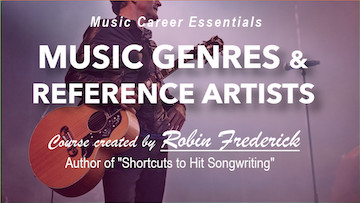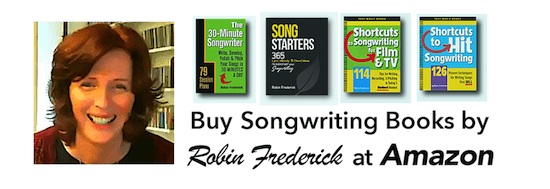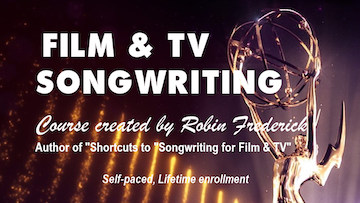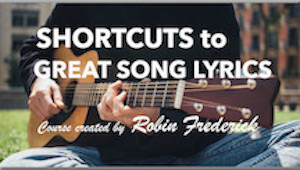Why this song?
Dermot Kennedy has written a great album. Hands down. No argument. That’s what it is. His debut album Without Fear was released in 2019 and has been hanging out on the Triple A music chart ever since.
There have been Film & TV placements, tours, and accolades for Kennedy’s unique blend of musical styles. He mixes a passionate Pop vocal sound with insightful Singer-Songwriter lyrics and Hip-Hop rhythms. So let’s take a look at a song from the album that shows off all three: “Outnumbered.”
“Outnumbered” – Dermot Kennedy
Songwriters: Dermot Kennedy, Jay Mooncie, Scott Harris, Stephen Kozmeniuk
TECHNIQUES TO HEAR AND TRY:
• Write a stand-alone chorus lyric..
• Choose words with the right associations.
• Blend genres in your melody.
• Use the power of the octave leap.
Listen to the song. Read the lyrics.
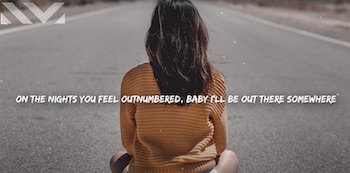
Watch the lyric video on YouTube.
Read the lyric here.
GENRE/STYLE: (Pop/Singer-Songwriter)
(What is a genre? Watch this video.)
Because genre-busting is central to Dermot Kennedy’s sound, it could be hard to pin down what genre he’s actually in.
▪ In “Outnumbered,” the looped acoustic guitar provides the four-chords needed for a straightforward topline approach to songwriting—common in the Pop, Hip-Hop, and Dance genres but not in Singer-Songwriter.
▪ The structure is essentially Pop, but the lyrics are emotionally revealing with a strong romantic undercurrent, closer to Singer-Songwriter than other genres.
I’m going to call this Pop/Singer-Songwriter and compare it to artists like Lewis Capaldi and Banners, two singer-songwriters who have done well on the mainstream Pop charts.
TIP: The Triple A (Adult Album Alternative) music chart is itself a mash-up of styles. It’s the closest thing we have to the crazy, creative collage of music that blew up on FM radio of the 1960s.
SONG STRUCTURE
This song form starts with a chorus.
CHORUS
VERSE A / VERSE B / PRE-CHORUS / CHORUS
VERSE A / VERSE B / PRE-CHORUS / CHORUS
BRIDGE / CHORUS
Opening lines…
VERSE 1A: “I could have showed you all the scars at the start…”
VERSE 1B: “I wrote some words and then I stared at my feet…”
VERSE 2A: “But there’s beauty here that’s yet to depart…”
VERSE 2B: “And there’ll be days when it’s difficult…”
PRE-CHORUSES: “To all the stars that light the road…”
CHORUS: “Don’t tell me this is all for nothing…”
BRIDGE (2:46) “How long can you wait for the one you deserve…”
TIP: The double verses (A and B) have different melodies. The A section is a monotone melody; there are no changes in pitch. The B section has more motion and also raises the pitch range by a couple of notes. The monotone melody of the A section would have become, well, monotonous if it had been used in both sections.
– Try It Now –
Listen to song and notice the melody change between Verse A and Verse B. How would you feel about the song if the melody remained the same in both?
LYRICS

WRITE A STAND-ALONE CHORUS: “Outnumbered”starts with the chorus. If you’re going to try this, keep in mind that the listener doesn’t know anything at all about the singer or the situation when the song begins. We use verses to give listeners information that leads them to the big, emotional chorus.
Without a verse, you have to go from zero to 60 right out of the gate. In that case, you’ll need to write a stand-alone chorus—one that doesn’t need a verse to explain the emotion or message.
“Outnumbered” features a stand-alone chorus—the lyric doesn’t need any explanation. It offers a clear statement of the singer’s feelings: I’ll be there for you even if we can’t be together.
I can only tell you one thing
On the nights you feel outnumbered
Baby, I’ll be out there somewhere
MORE USES FOR A STAND-ALONE CHORUS: If you’re writing songs for the Film & TV market, consider using a stand-alone chorus in all your songs, whether it opens the song or not.
Film & TV likes stand-alone choruses for a couple of reasons: 1) the script will take care of the story details: how they met, why they’re apart, why they need a love this strong; and 2) the editor will often cover up the verse with dialogue, then feature the chorus at the end of the scene. A stand-alone chorus allows the audience to relate to the emotion in the chorus without hearing the rest of the lyric.
– Try It Now –
Write a chorus lyric that doesn’t refer back to or rely on a verse for explanation. Avoid a line like “I’m sorry for the things I did…” if those things aren’t in the chorus! In the chorus of “Outnumbered,” the singer says “I can only tell you one thing…” and then he tells us what it is.
Stand-alone choruses aren’t needed in every song. But keep them in mind for Film & TV and songs that open with the chorus.
USE IMAGES WITH THE RIGHT ASSOCIATIONS: “Outnumbered” features a fairly common theme: Though we may be apart, I’ll always love you. But in this lyric, it’s given an epic setting! There are powerful forces, it seems, beyond the singer’s control pushing them apart.
The songwriters convey this “epic battle” quality through the language and imagery that fill this song: outnumbered, scars, soul, chaos, coward, kills, all the stars, fight on. Words and images like these trigger a feeling response in he listener. They don’t have to think about it; they feel it.
Find out more about trigger words.
Phrases like “fight on” and “all the stars” are associated with big events, omens, and challenges. In an interview, Dermot Kennedy talks about his love of books like The Lord Of The Rings, the Harry Potter series, and The Hobbit as he was growing up. This lyric captures a theme established in those books—the mythical hero undertaking a dangerous yet crucial journey.
– Try It Now –
It’s inspiring to draw on themes that capture your imagination and emotional attention. Think about the books you’ve read, movies you’ve loved, or TV series you binge on. What attracted you to them? Can you capture some of that in your songwriting?
MELODY
MIXING GENRES IN YOUR MELODY: What makes this melody unique is the contrast between the classic Pop elements of the chorus and the Hip-Hop style of the verses.
▪ The chorus: With its high note range, strong upward and downward motion, and smooth word-flow, the chorus is reminiscent of Pop hits by Lewis Capaldi, P!nk, and Adele.
▪ After the Pop chorus: The drop to the low note range and monotone melody of the verse is a real surprise. The flow of the notes and words also changes, from the conversational flow of the chorus to a more complex Hip-Hop rhythm that features short bursts of words in unpredictable places.
Pop and Hip-Hop melodies are very different. Pop melodies fall into rhythm patterns that are then repeated two or more times, often varying the note pitches. Hip-Hop melodies, on the other hand, feature more complicated note rhythms with less pitch motion. Making these two melody styles work together in a single song is a creative challenge.
Kennedy solves the problem by moving from one style to the other through a series of steps.
1. In the first four lines of the verse, the note pitches don’t move.
2. In the next four lines, there’s more motion in note pitch.
3. In the pre-chorus, the note range moves up and uses repeated melody patterns that reintroduce the Pop style.
4. The song then releases into the big Pop melody chorus.
After the abrupt drop from the opening Pop chorus to the Hip-Hop verse, the gradual move from Hip-Hop back to Pop feels pretty comfortable. At the end of the second chorus we know what to expect going from the Pop to the Hip-Hop verse melody again because we’ve heard it already.
– Try It Now –
Listen to “Outnumbered” and check out how the melody changes from section to section. In the verses, the rhythm patterns are hard to predict. In the pre-chorus, the melody rhythm patterns seem more predictable. The melody in the chorus uses Pop rhythm patterns that are more familiar and easier for the listener to remember.
Listen to the song melody and focus on the note rhythms used in each section or just let yourself feel the difference in the melody in each section of the song..
Take a look at some of your favorite successful songs to see how the melodies express the genre. Are there repeated phrases that are easy to pick out? What is the pattern of those repeats? Or is there a mix of phrases with different note rhythm patterns or melody pitches?
CHORDS
This is a four-chord progression that is repeated over and over throughout the song. You can play along with the track using these chords. No capo or transposing needed.
| F | C | G | Am |
See the chords with lyrics here.
PRODUCTION
The production is built on a single guitar loop. The arrangement starts and ends with the same loop. On the closing bars, the loop is ghosted by a high synth, otherwise it’s the same as the opening. In between, the track is built up with drums loops, synth pads, and vocal samples buried in reverb.
THE POWER OF THE OCTAVE:
After a big, passionate bridge section, the track’s intensity drops way down (at 3:09) to just the guitar loop. This is common in songs that share this song structure. What’s different here is that the vocal drops down, too. It’s a whole octave lower for the first half of the chorus.
This creates contrast allowing the big leap back up the octave to create a powerhouse ending to the song. It’s a great way to change up the dynamic of the song and grab the listener’s attention. I’ve never heard it done just this way before.
– Try It Now –
Find or create a simple loop like this one. You can use piano, guitar, or any instrument you like. Create a track by repeating the loop. Then either add chords, melody or both. You can use a lyric you’ve already written or write something new using some of the lyric tools described here.
Have fun with it. Don’t worry about making it perfect. This is just practice. Of course, if you end up with something you like, keep it!

